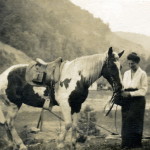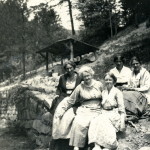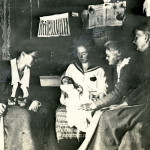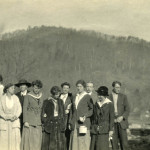Pine Mountain Settlement School
Series 09: BIOGRAPHY – Staff
Series 14: MEDICAL
Dr. Grace Huse, 1919-1924
Medical Settlement at Big Laurel
Dr. Grace Huse (1884-1971)
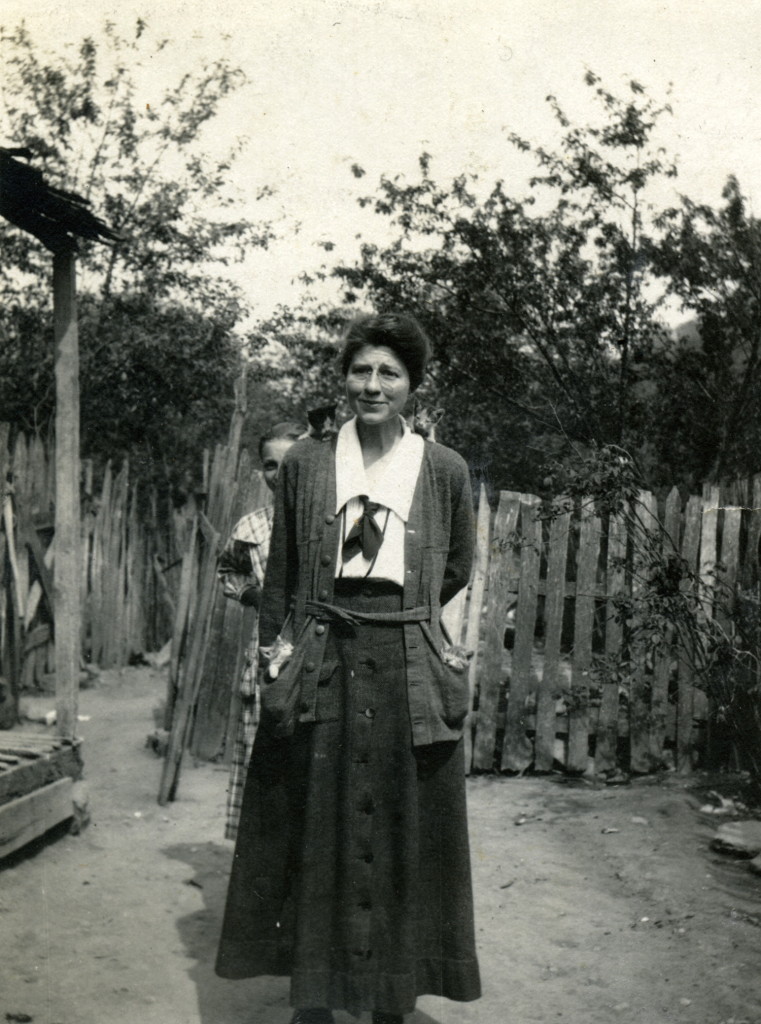
Grace Huse with kittens. [X_099_workers_2497a_mod.jpg]
TAGS: Washington College, Women’s Medical College of Pennsylvania, Women’s College of the University of North Carolina, instructors, physicians, Medical Settlement at Big Laurel, Harriet Butler, district nurses, district teachers, patients, pneumonia, gallstones, chokin’ disease, hookworm, fatalism, fees, Line Fork Settlement, Dr. Farrand, Infirmary
Dr. GRACE HUSE Staff
Physician, Medical Settlement at Big Laurel, 1919-1924
Before Pine Mountain
Dr. Grace Huse was from St. Louis, Missouri, and attended Washington College in St. Louis, where she earned an A.B. degree. She continued her medical studies at the Women’s Medical College, Philadelphia, Pennsylvania, where she earned her M.D.
In medical school she was an active member of the Alpha Epsilon Iota sorority and secretary of the school chapter of the Y.W.C.A. She is remembered by her cohorts in the 1911 “Scalpel” yearbook as follows:
That classmate of ours called “Hugh,”
Who always had so much to do.
That no time could she find
To culture her mind,
So of classes she cut quite a few.
She apparently came to the Women’s College at Greensboro, North Carolina, just after graduation from medical college and was there only briefly between 1913 and 1914 as an instructor and as the resident physician for the school.
Her classes at the Women’s College at Greensboro are described as follows:
I. Hygiene. — A brief course of lectures in practical care of health. Required of all students in their entrance year.
II. Physiology and Hygiene. — Three hours a week. For Seniors. Freshman Biology and General Chemistry are prerequisites. The course aims to give a practical knowledge of the cells, tissues, and organs of the body; of the general structure and functions; and to apply this knowledge to the consideration of diet and other practical hygiene.
The work is illustrated by simple laboratory exercises, use of microscope, and dissection of lower animals.Dr. GRACE HUSE Staff: At Pine Mountain
She came to Pine Mountain in 1919 and stayed for five years as a doctor at the Medical Settlement at Big Laurel. Her academic preparation in the medical sciences and her commitment to education were valuable assets in her new position at Pine Mountain, but it is unlikely she was prepared for the physical challenges of her rural settlement work. Even so, it is clear that she quickly got up to speed. Harriet Butler, a nurse who had worked at Hindman with Katherine Pettit and Ethel de Long was, no doubt, her mentor in the ways of the mountain people. Also, a wise administrator, Harriet Butler was near the end of her career, but she had an accumulated knowledge that benefited Huse in many ways.
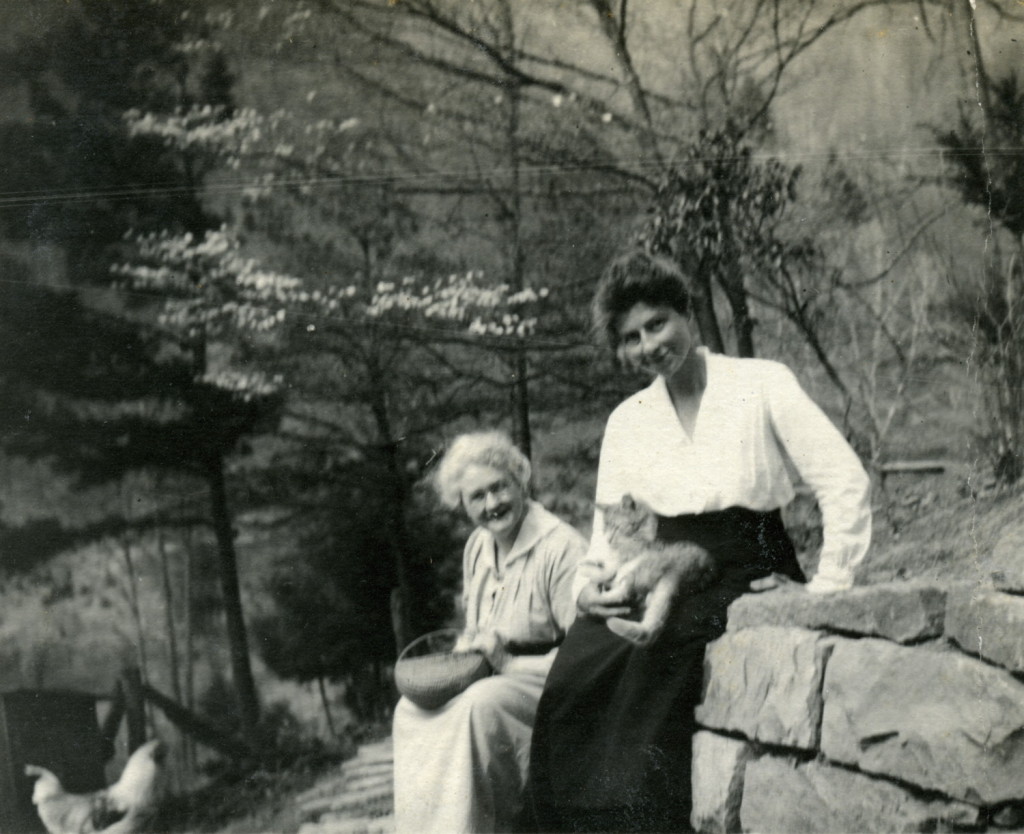
Harriet Butler, nurse and Dr. Grace Huse with cat. [X_099_workers_2497b_mod.jpg]
The Medical Settlement, begun by Miss Harriet Butler and Dr. Grace Huse, now includes a district nurse, the county school teacher for Big Laurel, and a general “roustabout” with miscellaneous and innumerable duties.
Can you imagine a day in that little log house: The family must get a “soon start,” for often there are patients at the doctor’s office before six, and the women must get their own work done early so as to be ready for the day. Like as not the doctor has been called in the night, on a baby case perhaps, so the nurse treats the bad eye or dresses the sore leg before she starts off. Often they all eat breakfast with several people visiting them or waiting for medicine.
Miss Butler, whose vision shapes the work of the settlement, is the stay-at-home in that house by the side of the road. The others fare forth afoot or on horseback. She keeps the hearth bright for them and for the neighbors, sees all who come, feels the pulse of things and plans.
You will have to know Dr. Huse to appreciate the devotion the whole country gives her. The only “diplomy doctor” in a circle of twenty-five miles, she rides her horse Billy by day and night (she has never refused a call), wet, hungry, muddy, frozen, exhausted, to take care of the sick and introduce little new-comers to a world incredibly happier and more wholesome for them because of her.
A mother lost six children with pneumonia. The youngest child falls sick with it, and thanks to the doctor and the district nurse, is pulled through. Do you wonder that the father says that no doctor who has studied all over Ameriky and Europe can beat her? A woman is saved from death in an acute and terrible attack of gallstones. A child, stricken with “the chokin’ disease,” is saved by an antitoxin given when there is barely room for hope. No wonder they can scarcely spare her to visit her kinfolk for a few weeks in the year. Before her, whose skill, gentleness, and wisdom make her an ideal doctor for this country, there was no one to help them, and dumb hearts tried to find comfort in a stark fatalism, —“I reckon his time has come; he’s aimin’ to die.”
The most cheerful group you can find in our country is the doctor’s babies, and it is a marvel to contrast them with their older brothers and sisters, who came into the world by the hands of a midwife and were lucky if there was anything but an apron for them to be wrapped in. The doctor’s regular fee for a baby case is $5.00, two and a half times the mid-wife’s. but everyone wants her in spite of this contrast. Through outside friends she has provided layettes, entirely simple yet perfectly adequate, to sell at low prices to mothers who know better how to split rails or lay by a corn crop than to fashion baby garments. Sometimes a woman might have to go across the mountain to the next creek to borrow a needle for this work, and everyone knows that little clothes are harder to make than full sized ones. For two years now the babies have found things ready for them, bought by their mothers, and not an outsider’s gift. And how the mothers have tried to bathe and clothe and feed the babies, according to the doctor’s directions! As we remember the sore-mouthed, sore-eyed, sore-headed, fly-covered babies of three years ago, suffering too from sick stomachs or locked bowels, we rub our eyes at the rosy, fresh babies of today.
The doctor charges for her visits from fifty cents to five dollars, according to the distance she has to go, and the circumstances. Fees for office calls vary from five cents to twenty-five, the doctor wishing through low fees that do little more than pay for the medicine, to build up her office practice. In spite of the lack of money in this country, and the many feet to be shod in most homes, she has no bad debts, and is always paid promptly.
A large part of her time is given to our big family, and to directing the work of the nurse at our school infirmary. Beside its preventive aspect, and the examinations and watchful care required to build up every one of our children, there is a most important curative and corrective side, which includes hookworm treatments, prescriptions for glasses, operative cases to be got off to Louisville, as well as the care of sickness and broken bones. The Line Fork Settlement nurse looks to her for direction and for help in emergencies.
In all this work the district nurse is the doctor’s staunch ally. A whole family has hookworm and has asked for treatment. She will stay with them two days and get them through it. The mother of twelve wants her last baby to be better cared for than the other eleven. The nurse spends the day with her, and tells her just when to feed it and when to ignore untimely cries. Since last March, Miss Peters has not had one day’s vacation, for beside her great Sunday School class on Sunday, she often goes out on that day to see after some of her patients.
And do not forget the roustabout, who helps the district teacher with her over-crowded school, plays with the children on the Settlement playground, a marvellous piece of level land big enough for even a baseball game, teaches sewing and is generally accessible to everybody.
Dr. Farrand, in his inaugural address at Cornell, said that the immense problem of today is the rescue of civilization. That is the Medical Settlement’s problem also. Social, economic, and moral factors in the lives of the elders bid fair to destroy the ancient civilization of the mountains. To rescue it, and set the feet of the children in a fair path, is the great task at Big Laurel.
Dr. GRACE HUSE Staff: PMSS Medical Settlement and the Greensboro Campus
This testimony regarding the medical assistance of Dr. Huse in the Big Laurel community is strikingly different from the picture painted by a student of the doctor’s work in the 1914 yearbook of the Women’s College in Greensboro. This account, told with some irony, captures the “gentility” of the college setting and the nature of the patients Dr. Huse was used to at the college.
Among the six hundred of us, there are always the ailing. They are in two classes, the chronic ailers and the chance ailers. The chronic ailers give occupation to Miss Pattie and Dr. Huse and make them earn their pay. They spend week-ends with Miss Pattie with the same grace that the rest of us spend a free day in the library or on the tennis court. Therefore when we consider the Infirmary as a place for acquirement of unique experiences, we can hardly consider their viewpoint. It is the chance and perhaps acute ailer who really knows the Infirmary as a house apart. Behold the timid Freshman with her first ailment, a blistered heel. She goes to see Miss Pattie, exactly at the right time — immediately after breakfast — and is instructed to remove her shoes while Miss Pattie bustles about, preparing a hot water examination. The inexperienced new girl dares not but insert her foot in the steaming water nor remove it before the august lady’s good pleasure. After a thorough investigation of the trouble, she is directed to send for her suitcase and take a room upstairs. There she is duly installed on a high bed with the foot, now blistered all over instead of merely on the heel, placed in an antiseptic solution just from the boiler. When hope begins to rise in the heart of the unfortunate cripple with the growing comfort of her foot in the cooling water, the maid arrives with a freshly heated supply. About noon, the young lady receives her books and other impedimenta. Never did a French grammar seem so refreshing. Even a Latin lexicon has a lovingly familiar look. She attacks her Cicero with enthusiasm and reads beyond the assignment.
The “occupations” that Dr. Huse engaged at the two locations — the Medical Settlement at Big Laurel and the Greensboro campus — stand in stark contrast to one another, but both were vital in addressing the health of the country in the first part of the twentieth century. The early experiences and models provided by Dr. Huse and nurse, Harriet Butler, and other women who worked in the extensions centers, are only part of the rich medical legacy in Appalachia inherited from the rural settlement movement.
**********
Grace Huse was born on November 19, 1884, in St. Louis, Missouri. She was one of Ellen “Nellie” L. Huse’s four daughters and possibly a twin of Gertrude Huse’s who was the same age. She died November 1971 in Franklin, Missouri.
Dr. GRACE HUSE Staff: GALLERY
- Dr. Grace Huse with her horse at Medical Settlement, Big Laurel. [X_099_workers_2494b_mod.jpg]
- Workers at Medical Settlement, Big Laurel. From left: Miss Watts, Harriet Butler, nurse, Ann Cobb (Hindman), Dr. Grace Huse, unknown (?).[X_099_workers_2496_mod.jpg]
- (left to rt) Dr. Grace Huse, woman with baby, Harriet Butler, and older woman. Home is decorated with magazine pages and crochet. [X_099_workers_2498_mod.jpg]
- Dr. Grace Huse to far right with children and two adults. Note large hickory basket. Possibly Old Laurel House at PMSS. [X_099_workers_2520_mod.jpg]
- PMSS workers (from left): Katherine Pettit, Ethel de Long, Wilmer Stone, [?], Ruth Hench, Dr. Grace Huse, [?], Evelyn Wells [?], Marguerite Butler, Luigi Zande. [X_099_workers_2489]
Click on image to enlarge.
See Also:
DR. GRACE HUSE Correspondence, 1921 – 1924
MEDICAL Staff Lists
MEDICAL SETTLEMENT Big Laurel
|
Title |
Dr. Grace Huse |
|
Alt. Title |
Grace Huse ; Dr. Huse ; |
|
Identifier |
|
|
Creator |
Pine Mountain Settlement School, Pine Mountain, KY |
|
Alt. Creator |
Ann Angel Eberhardt ; Helen Hayes Wykle ; |
|
Subject Keyword |
Pine Mountain Settlement School ; Washington College ; Women’s Medical College ; Alpha Epsilon Iota ; YWCA ; Scalpel Yearbook ; Carolinian Yearbook ; Women’s College ; secretaries ; instructors ; physicians ; hygiene classes ; physiology classes ; Medical Settlement at Big Laurel ; Notes from the Pine Mountain Settlement School ; Harriet Butler ; roustabouts ; district nurses ; district teachers ; patients ; horseback ; pneumonia ; gallstones ; chokin’ disease ; hookworm ; fatalism ; fees ; layettes ; Line Fork Settlement ; Miss Peters ; playground ; Dr. Farrand ; Cornell ; Miss Pattie ; infirmary ; Ellen “Nellie” L. Huse ; Gertrude Huse ; Pine Mountain, KY ; Harlan County, KY ; St. Louis, MO ; Philadelphia, PA ; Greensboro, NC ; Louisville, KY ; Line Fork, KY ; Franklin, MO ; |
|
Subject LCSH |
Huse, Grace, — 1884 – 1971. |
|
Date |
2013-11-13 |
|
Publisher |
Pine Mountain Settlement School, Pine Mountain, KY |
|
Contributor |
n/a |
|
Type |
Text ; image ; |
|
Format |
Original and copies of documents and correspondence in file folders in filing cabinet |
|
Series 09: BIOGRAPHY ; Series 14: MEDICAL |
|
|
Language |
English |
|
Relation |
Is related to: Pine Mountain Settlement School Collections, Series 09: BIOGRAPHY ; Series 14: MEDICAL |
|
Coverage Temporal |
1884 – 1971 |
|
Coverage Spatial |
Pine Mountain, KY ; Harlan County, KY ; St. Louis, MO ; Philadelphia, PA ; Greensboro, NC ; Louisville, KY ; Line Fork, KY ; Franklin, MO ; |
|
Rights |
Any display, publication, or public use must credit the Pine Mountain Settlement School. Copyright retained by the creators of certain items in the collection, or their descendants, as stipulated by United States copyright law. |
|
Donor |
n/a |
|
Description |
Core documents, correspondence, writings, and administrative papers of Grace Huse ; clippings, photographs, books by or about Grace Huse ; |
|
Acquisition |
n/d |
|
Citation |
[Identification of Item],” [Collection Name] [Series Number, if applicable]. Pine Mountain Settlement School Institutional Papers. Pine Mountain Settlement School, Pine Mountain, KY. |
|
Processed By |
Helen Hayes Wykle ; Ann Angel Eberhardt ; |
|
Last Updated |
2013-11-13 hhw ; 2013-11-24 aae ; 2021-07-11 aae ; 2023-10-09 aae ; |
|
|
Sources Notes from the Pine Mountain Settlement School. I.6 (November 1921): 1 – 2. Series 09: Staff/Personnel. Pine Mountain Settlement School Institutional Papers. Pine Mountain Settlement School, Pine Mountain, KY. Internet resource. “United States Census, 1910,” index and images. FamilySearch. https://familysearch.org/pal:/MM9.1.1/MLMM-F5N (accessed 2013-11-23). Grace Huse in household of Nellie Huse, St Louis Ward 28, St Louis (Independent City), Missouri, United States; citing sheet, family 275, NARA microfilm publication T624, FHL microfilm 1374836. Internet resource. “United States Social Security Death Index,” index. FamilySearch. https://familysearch.org/pal:/MM9.1.1/V3FM-H4C (accessed 2013-11-23). Grace Huse, November 1971; citing U.S. Social Security Administration, Death Master File, database (Alexandria, Virginia: National Technical Information Service, ongoing). Internet resource. The Women’s Medical College of Pennsylvania. “Scalpel” Yearbook. (1911): 98. http://archive.org/stream/scalpel11woma/scalpel11woma_djvu.txt (accessed 2013-11-24). Internet resource. The Women’s College of the University of North Carolina at Greensboro. “The Carolinian.” (1914): 24 and 200. Internet Archive. http://www.archive.org/stream/TheCarolinian1914/1914-edit_djvu.txt (accessed 2013-11-18). Internet resource. |
Return To:
BIOGRAPHY – A-Z
MEDICAL Guide
MEDICAL Staff Lists

